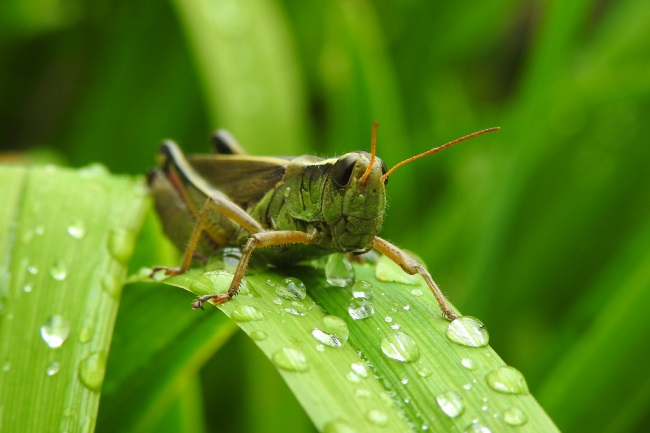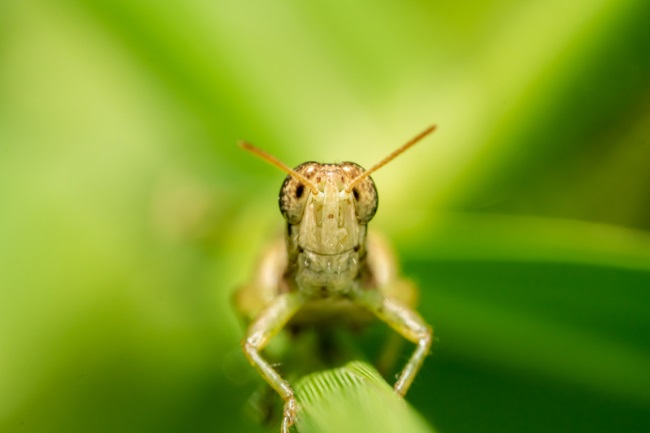Grasshoppers do breathe and need air to survive; however, they do not have a nose. Instead, they breathe through spiracles, holes in their abdomen and thorax that allow gas exchange.
Contents
Who needs a nose?

There’s something rather alien about insects when you get up close and personal with them. This sense of unfamiliarity is probably due to how they have evolved to manage similar problems to us with different anatomical tricks. For example, like us, they need to breathe, exchanging internal gases for external ones on a regular basis. Yet, if you get up close and personal with a grasshopper’s face, you’ll quickly realise they don’t have a nose.
This may seem rather strange when all else on the head appears to be in the right place. Grasshoppers have two large compound eyes, which are made up of many smaller lenses. Although this may seem similar to us, in between these two compound eyes, they actually have three simple eyes, which aren’t immediately apparent.
| Feature | Tracheal System | Spiracles |
|---|---|---|
| Function | Gas exchange | Opening/closing of respiratory system |
| Location | Inside the body | On the surface of the body |
| Structure | Network of tubes | Small openings |
| Functionality | Direct oxygen uptake | Control of gas exchange |
| Advantage | Efficient oxygen transport | Protection against water loss |
| Disadvantage | Vulnerable to blockages | Limited control over gas exchange |
They also have a mouth, which they use for cutting and chewing their food. Unlike us, they have several different mouthparts, including mandibles. One thing that they don’t have in common with us are antennae. These are very important for insects, allowing them to access all sorts of sensory information, such as touch, smell and temperature.
So although the mouth and the eyes are almost in the right place, what’s missing from our cricket head are the ears and the nose. Bizarre as it may seem, grasshoppers actually have their ears on their abdomen, essentially the belly area. These do not look like a human ear but have a very similar makeup, with a membrane acting as a kind of drum. They are usually protected by their wing casings in adults.
So, where is their nose? Like all insects, grasshoppers don’t bother with a nose in the same way we do. Instead, they have a number of holes along their thorax and abdomen called spiracles. In most grasshoppers there are ten, five on each side of the body. One set is on the thorax and the rest along the abdomen. These spiracles allow gas exchange, taking in air to a set of long tubes that run down the body called the trachea. These take in the gas and send it into tracheoles, which are branches that allow grass exchange feeding the air into muscles. These act similar to the branches like those in our lungs. It’s the flexing of the abdominal muscles that pump air around the body.
Unlike our nostrils, spiracles have a valve-like structure that enables them to shut. Small hairs also surround them in order to capture any dust particles and prevent them from entering the grasshopper. These hairs function in a similar manner to our nose hairs.
Besides beneficial gases, the grasshopper’s body will absorb those that would be damaging if they were allowed to accumulate. Like most insects, the grasshopper doesn’t produce urine to get rid of some of this waste. Instead, they have Malpighian tubes. These tubes help harmful chemicals, such as nitrogens, to be taken out of the grasshopper haemolymph (blood). This waste will then make its way down to be expelled with the faeces.
The problem with breathing
Insects generally have a bit of a problem with water retention and can quickly overheat or dry out. In order to avoid losing too much moisture when they breathe, they will often close their spiracles. To see how much moisture you lose when you breathe, all you need to do is exhale out onto a piece of glass and see the steam mist up the glass.
The shape of the spiracles is similar to stomata in plants, which are also designed to avoid excess water loss. However, some scientists are still unconvinced that significant water loss occurs in this way.
| Stage | Description |
|---|---|
| Inhalation | Grasshopper expands its body, drawing air in |
| Oxygen Exchange | Oxygen diffuses from the tracheal tubes to cells |
| Carbon Dioxide Release | Carbon dioxide diffuses from cells to tracheal tubes |
| Exhalation | Grasshopper contracts its body, releasing air |
While horror movies with giant insects may well be appealing for all kinds of reasons, the way insects breathe is one of the factors that make this completely impossible. Because of their restrictions in terms of taking air into their bodies, there’s only so big they can get before they can’t breathe quickly enough to survive. In the past, oxygen levels in the atmosphere were much higher, allowing lots of lifeforms to become supersized.

Even beyond their breathing restrictions, the hard outer skeleton of invertebrates adds an additional challenge. As they become more extensive, it becomes thicker and heavier until eventually, it would be far too weighty to allow them to move.
Even though grasshoppers are small, they still need a good supply of air. It’s therefore essential that all containers that grasshoppers are temporarily or permanently stored in have air holes to allow new air to flow in, and any gases to escape.
Can grasshoppers breathe underwater?

Despite their need for air, there are some grasshoppers that are happy within the water. The water-hyacinth grasshopper is known for eating this often invasive plant. Yet, unlike some semiaquatic insects, they haven’t developed an alternative respiratory system, still needing to use their spiracles to get a good breath of air.
Not all grasshoppers will survive a brush with water, though. While the water-hyacinth grasshopper is a great swimmer, most grasshoppers are not. The parasitic Nematomorph hairworm brainwashes its grasshopper and cricket hosts into drowning themselves for its benefit. The parasite grows inside them as they go about their business on the land before manipulating their brain chemistry to entering the water once the hairworm is ready to emerge into its aquatic form.
Breathe deep
Although grasshoppers are very different from us anatomically, they need very much the same as us. The way they breathe prevents them from growing beyond a specific size and risks causing them to desiccate. Yet, having been around since well before the dinosaurs, and with approximately 8,000 species worldwide, they can’t be too held back by their lack of a nose!

